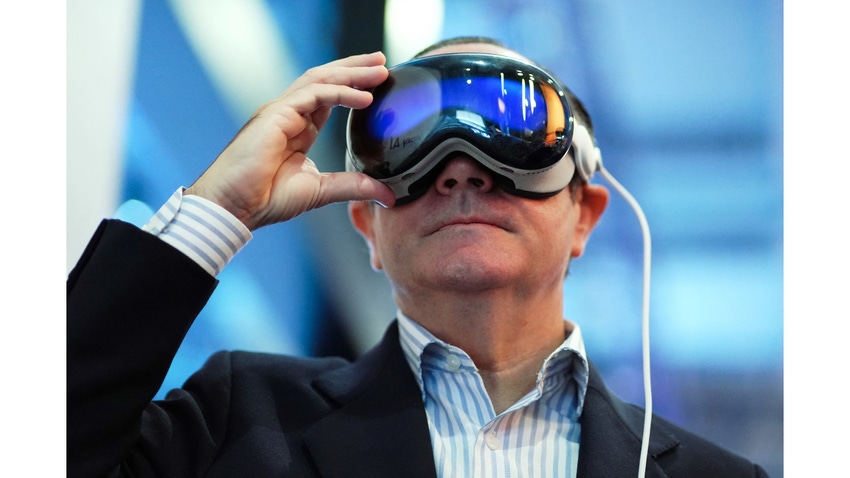Apple’s Vision Pro: Costly Toy or Computing’s Future?
The polarizing headset has its critics, but others believe the AR/VR device can become a game-changer.

At a Glance
- Apple's Vision Pro headset has been selling at a steady if not breakneck pace for its first month of availability
- Early users have expressed concerns about the headset's comfort.
- Opinion remains divided over the headset's long-term prospects.
When Apple showed off its futuristic Vision Pro headset last June, reaction was mixed. While Apple pulled out all stops to present the device as a product that would revolutionize future computing, critics said the headset was too costly to make a significant impact on the consumer electronics landscape initially.
Fast forward to the beginning of March, and Apple has now been selling the device for several weeks. The jury remains out. Some users believe the device can fundamentally change the way we work, while others are less than impressed with the device’s usability over some time. Still, others wonder whether spending considerable time wearing a headset−whether Vision Pro or some other headset− is good from a social interaction viewpoint.
Production and Sales Limited
Jumping to conclusions about the Vision Pro headset's future would be premature at this point, given the product’s high cost and relatively limited market. The headset is a complex product comprising many parts that even frustrate teardown experts, and whose potential will take a long time to fully realize until more apps and uses are found. Acknowledging these issues, Apple has taken a measured approach to bringing the headset to market, limiting production and tempering sales expectations at the outset.
But If anything, the initial reaction to the device is encouraging. A recent article on the site Macrumors was quoted as saying Apple had sold 160,000 to 180,000 units during the pre-order weekend for the device and has sold upwards of 200,000 headsets so far.
According to a story on Technopedia, Apple initially targeted sales of 350,000 Vision Pro headsets in its first year, indicating the company is well on its way to meeting first-year sales goals. While sales are expected to drop off, the same article predicts a faster ramp-up next year, with Vision Pro sales pegged at 1,475,000 for the device’s second year of existence a whopping projected 321% increase.
Overcoming Limitations
For the headset to meet those lofty sales targets, Apple will have to convince the buying public of the device’s value. The company wants to promote a new way to approach computing with the headset they say will increase productivity.
In a review on howtogeek.com, the reviewer marveled about being able to keep several apps visible and open at the same time, instead of having to go back and forth between apps on other mobile devices or rearranging screens on a laptop. Moreover, the reviewer noted that all the apps are clearly visible without having to shuffle windows to make them more visible.
AI researcher Dan Faggella, Founder and Head of Research at Emerj Artificial Intelligence Research, said in an e-mail reply, “One significant advantage is the headset's ability to provide a ubiquitous interface, allowing users to stay informed and engaged with notifications and tasks while performing everyday activities like household chores or walking the dog. The integration of voice transcription further enhances productivity by enabling users to respond to messages or delegate tasks hands-free.”
Faggella added, “The headset's display capabilities offer flexibility by allowing users to create multiple customized virtual displays tailored to their specific tasks and preferences. This means users can replicate the productivity benefits of a multi-monitor setup in various environments, such as reclining on a couch or sitting at a kitchen table, thus enhancing their efficiency and workflow.”
There are a few early hints users are finding applications for the Vision Pro, for instance in medicine. #eXeX™, a leader in artificial intelligence and mixed reality enhanced surgical performance, is working with surgical teams from The Cromwell Hospital London, to perform a surgical procedure using the new Apple Vision Pro to enhance performance. The headset is teaming with the company’s immersive software to enhance the workflow and organization of surgical teams, helping to create an immersive and touch-free environment to help nurses and technicians set up and aid in surgical procedures, providing information, procedural guides, and virtual maps.
Wearer Comfort Remains an Issue
Ergonomic and usability issues remain paramount in the minds of early Vision Pro adopters as well as industry analysts and observers.
For instance, the howtogeek.com reviewer said he has had to keep adjusting the Vision Pro headset, particularly the strap configuration, to achieve some type of comfort wearing it for extended periods.
Aaron Franko, VP of Immersive Technology at Saritasa, said in an e-mail reply, “The headset is slightly front-heavy so there is a bit of neck strain. That said, I found no issue wearing the headset for an hour while testing it. I think, generally most people need a break from headset-based applications every 1 to 2 hours regardless of type.”
Room for Improvement
Without a doubt, Apple is likely to make changes in future versions of the Vision Pro. Already, some users are chiming in with suggestions. Saritasa’s Aaron Franko said, “The three areas that I’d recommend for improvement are comfort, visual sharpness, and control. As mentioned, the balance of the device is a little off so, especially given the cost, an upgraded headstrap would make sense. Next, because the AVP is so focused on high-resolution visuals, it tends to blur the areas that aren’t in the direct field of view more significantly than other headsets. It would be interesting to see if there could be different “modes” that adjust this feature and possibly reduce resolution but create a wider “in focus” field of view. Finally, I think some inexpensive, optional hand controllers would be beneficial."
Industry observers warn that practical uses must be found for headset to avoid it becoming just another costly gadget. Emerj’s Dan Faggella, said, “AR/VR devices like the VisionPro headset also present some drawbacks and concerns. One major consideration is the risk of over-reliance on immersive virtual experiences, which could lead to issues such as addiction, distraction, and decreased engagement with the physical world. There's also a need to address concerns related to privacy, data security, and the ethical implications of AI-generated virtual environments.”
But more positive reviews emanate from The next TechCheck podcast, which discusses tech trends. Podcast hosts Leonard Lee, a tech industry analyst, and Mark Vena, SmartTech Research Founder, believe that Apple’s Vision Pro headset will establish a standard for immersive reality applications that other vendors will be challenged to keep up with. Both praised Apple’s interface and stated that would help new users scale the learning curve for the device.
Lower Price Upcoming?
Arguably the biggest hurdle with the Vision Pro is its steep $3,499 price tag. According to an article in Tom’s Guide, there may be a glimmer of hope. Analyst Ming-Chi Kuo hinted that Apple could bring out a less expensive version of the headset in 2026, with the next major revision of the Vision Pro not due until at least 2027.
About the Author(s)
You May Also Like





